(完整版)心理学专业英语复习资料
- 格式:doc
- 大小:134.51 KB
- 文档页数:12

《心理学专业英语》教学大纲王国芳编写应用心理学专业课程教学大纲958 目录前言 (960)chapter 1 PERSPECTIVES IN PSYCHOLOGY (961)1.1 Approaches to psychology (961)1.2 Controversies in psychology (963)1.3 Ethical issues in psychology (964)Reviews and exercises(Answer the following questions in English): (964)Extension readings: (964)Chapter 2 RESEARCH METHODS (965)2. What do psychologists investigate? (965)Reviews and exercises(Answer the following questions in English): (967)Extension readings: (967)Chapter3 COGNITIVE PSYCHOLOGY (968)3.1 Perception (968)3.2 Attention (969)3.3 Memory (969)Reviews and exercises(Answer the following questions in English): (971)Extension readings: (971)Chapter 4 Developmental Psychology (972)4.1 Early socialization (972)4.2 Cognitive development (973)4.3 Later Socialisation (974)Reviews and exercises(Answer the following questions in English): (975)Extension readings: (975)Chapter5 Social Psychology (976)5.1 Social influence (976)5.2 Pro- and anti- social behaviour (977)5.3 Social relationships (978)Reviews and exercises(Answer the following questions in English): (979)Extension readings: (979)Chapter 6 Comparative Psychology (980)6.1 Reproductive Strategies (980)6.2 Kinship and social behaviour (981)6.3 Behaviour analysis (982)Reviews and exercises(Answer the following questions in English): (982)Extension readings: (983)Chapter7 Biopsychology (984)7.1 Cortical functions (984)7.2 Awareness (985)7.3 Motivation and emotion (986)Reviews and exercises(Answer the following questions in English): (987)心理学专业英语Extension readings: (987)Chapter8 Abnormal psychology (988)8.1 Conceptions of abnormality (988)8.2 Psychopathologies (989)8.3 Therapeutic approaches (990)Reviews and exercises(Answer the following questions in English): (991)Extension readings: (991)959应用心理学专业课程教学大纲960前言《心理学专业英语》是应用心理学专业的一门专业方向必修课,授课时间为一个学期 36 学时,修 2 学分。
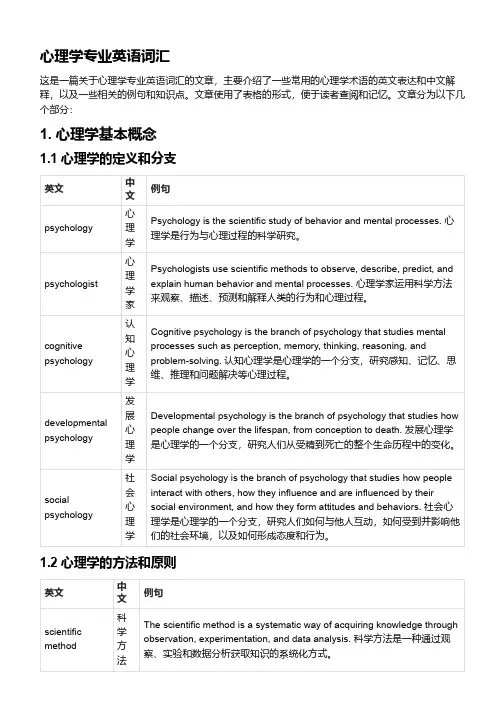
心理学专业英语词汇这是一篇关于心理学专业英语词汇的文章,主要介绍了一些常用的心理学术语的英文表达和中文解释,以及一些相关的例句和知识点。
文章使用了表格的形式,便于读者查阅和记忆。
文章分为以下几个部分:1. 心理学基本概念1.1 心理学的定义和分支英文中文例句psychology 心理学Psychology is the scientific study of behavior and mental processes. 心理学是行为与心理过程的科学研究。
psychologist 心理学家Psychologists use scientific methods to observe, describe, predict, and explain human behavior and mental processes. 心理学家运用科学方法来观察、描述、预测和解释人类的行为和心理过程。
cognitive psychology 认知心理学Cognitive psychology is the branch of psychology that studies mentalprocesses such as perception, memory, thinking, reasoning, andproblem-solving. 认知心理学是心理学的一个分支,研究感知、记忆、思维、推理和问题解决等心理过程。
developmental psychology 发展心理学Developmental psychology is the branch of psychology that studies how people change over the lifespan, from conception to death. 发展心理学是心理学的一个分支,研究人们从受精到死亡的整个生命历程中的变化。
social psychology 社会心理学Social psychology is the branch of psychology that studies how people interact with others, how they influence and are influenced by theirsocial environment, and how they form attitudes and behaviors. 社会心理学是心理学的一个分支,研究人们如何与他人互动,如何受到并影响他们的社会环境,以及如何形成态度和行为。
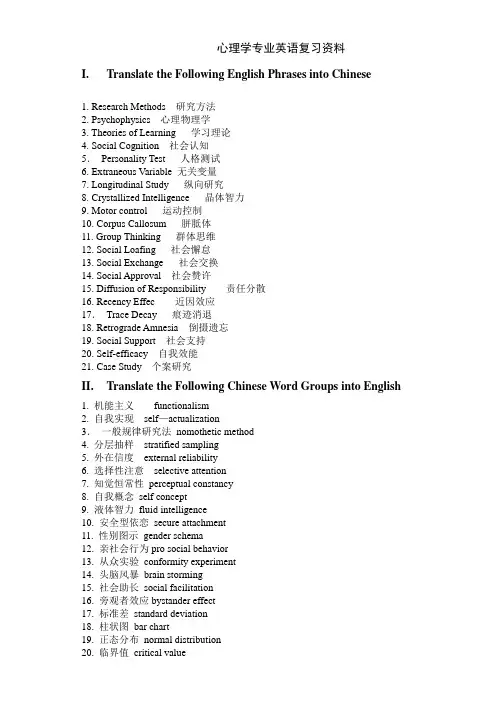
心理学专业英语复习资料I. Translate the Following English Phrases into Chinese1. Research Methods 研究方法2. Psychophysics 心理物理学3. Theories of Learning 学习理论4. Social Cognition 社会认知5.Personality Test 人格测试6. Extraneous Variable 无关变量7. Longitudinal Study 纵向研究8. Crystallized Intelligence 晶体智力9. Motor control 运动控制10. Corpus Callosum 胼胝体11. Group Thinking 群体思维12. Social Loafing 社会懈怠13. Social Exchange 社会交换14. Social Approval 社会赞许15. Diffusion of Responsibility 责任分散16. Recency Effec 近因效应17.Trace Decay 痕迹消退18. Retrograde Amnesia 倒摄遗忘19. Social Support 社会支持20. Self-efficacy 自我效能21. Case Study 个案研究II. Translate the Following Chinese Word Groups into English1. 机能主义functionalism2. 自我实现self—actualization3.一般规律研究法nomothetic method4. 分层抽样stratified sampling5. 外在信度external reliability6. 选择性注意selective attention7. 知觉恒常性perceptual constancy8. 自我概念self concept9. 液体智力fluid intelligence10. 安全型依恋secure attachment11. 性别图示gender schema12. 亲社会行为pro social behavior13. 从众实验conformity experiment14. 头脑风暴brain storming15. 社会助长social facilitation16. 旁观者效应bystander effect17. 标准差standard deviation18. 柱状图bar chart19. 正态分布normal distribution20. 临界值critical value21. 知觉适应perceptual adaptationIII. Multiple Choices1. Like Carl Rogers, I believe people choose to live more creative and meaningful lives. My name isa. Wertheimer.b. Washburn.c. Skinner.d. Maslow.2. The goals of psychology are toa. develop effective methods of psychotherapy.b. describe, predict, understand, and control behavior.c. explain the functioning of the human mind.d. compare, analyze, and control human behavior.3. The "father" of psychology and founder of the first psychological laboratory wasa. Wilhelm Wundt.b. Sigmund Freud.c. John B. Watson.d. B. F. Skinner.4. You see a psychologist and tell her that you are feeling depressed. She talks to you about the goals you have for yourself, about your image of yourself, and about the choices that you make in your life and that you could make in your life. This psychologist would probably belong to the __________ school of psychology.a. humanisticb. psychodynamicc. behavioristicd. Gestalt5. Biopsychologistsa. limit the scope of their study to animals.b. are concerned with self-actualization and free will.c. stress the unconscious aspect of behavior.d. attempt to explain behavior in terms of biological or physical mechanisms.6. In a study of effects of alcohol on driving ability, the control group should be givena. a high dosage of alcohol.b. one-half the dosage given the experimental group.c. a driving test before and after drinking alcohol.d. no alcohol at all.7.The phrase "a theory must also be falsifiable" meansa. researchers misrepresent their data.b. a theory must be defined so it can be disconfirmed.c. theories are a rich array of observations regarding behavior but with few facts to support them.d. nothing.8. A common method for selecting representative samples is to select thema. randomly from the larger population.b. strictly from volunteers.c. by threatening or coercing institutionalized populations.d. from confidential lists of mail order firms.9. The chief function of the control group in an experiment is that ita. allows mathematical relationships to be established.b. provides a point of reference against which the behavior of the experimental group can be compared.c. balances the experiment to eliminate all extraneous variables.d. is not really necessary.10. Which of the following best describes a double-blind experimental procedure?a. All subjects get the experimental procedure.b. Half the subjects get the experimental procedure, half the placebo; which they receive is known only to the experimenter.c. Half the subjects get the experimental procedure, half the placebo; which they receive is not known to subjects or experimenters.d. All subjects get the control procedure.11. A simple experiment has two groups of subjects calleda. the dependent group and the independent group.b. the extraneous group and the independent group.c. the before group and the after group.d. the control group and the experimental group.12. One of the limitations of the survey method isa. observer bias.b. that it sets up an artificial situation.c. that replies may not be accurate.d. the self-fulfilling prophecy.13. To replicate an experiment means toa. use control groups and experimental groups.b. use statistics to determine the effect of chance.c. control for the effects of extraneous variables.d. repeat the experiment using either identical or improved research methods.14. Information picked up by the body's receptor cells is termeda. cognitionb. perception.c. adaptation.d. sensation.15. The incoming flow of information from our sensory systems is referred to asa. sensation.b. perception.c. adaptation.d. cognition.16. A researcher presents two lights of varying brightness to a subject who is asked to respond "same" or "different" by comparing their intensities. The researcher is seeking thea. just noticeable difference.b. absolute threshold.c. subliminal threshold.d. minimal threshold.17. Film is to camera as __________ is to eye.a. retinab. irisc. lensd. pupil18. Black and white vision with greatest sensitivity under low levels of illumination describes the function ofa. the cones.b. the visual pigments.c. the rods.d. the phosphenes.19. Unpleasant stimuli may raise the threshold for recognition. This phenomenon is calleda. aversive stimulation.b. absolute threshold.c. perceptual defense.d. unconscious guard.20. When infants are placed in the middle of a visual cliff, they usuallya. remain still.b. move to the shallow side of the apparatus.c. move to the deep side of the apparatus.d. approach their mothers when called, whether that requires moving to the shallow or deep side.21.The fact that objects that are near each other tend to be grouped together is known asa. closure.b. continuation.c. similarity.d. nearness.22. An ability to "read" another person's mind is termeda. clairvoyance.b. telepathy.c. precognition.d. psychokinesis.23. The fact that infants will often crawl off tables or beds shows thata. depth perception is completely learned.b. human depth perception emerges at about 4 months of age.c. integration of depth perception with motor skills has not yet been accomplished.d. depth perception is completely innate.24. Sensations are organized into meaningful perceptions bya. perceptual constancies.b. localization of meaning.c. perceptual grouping (Gestalt) principles.d. sensory adaptation.25. The analysis of information starting with features and building into a complete perception is known asa. perceptual expectancy.b. top-down processing.c. bottom-up processing.d. Gregory's phenomenon.26.One recommended way for parents to handle problems of occasional bed wetting in children is toa. limit the amount of water they drink in the evening.b. punish them for "wet" nights.c. wake them up during the night to use the toilet.d. consider medication or psychotherapy.27. Teachers, peers, and adults outside the home become important in shaping attitudes toward oneself in Erikson's stage ofa. trust versus mistrust.b. initiative versus guilt.c. industry versus inferiority.d. integrity versus despair.28. With aging there is a decline of __________ intelligence, but not of __________ intelligence.a. fluid; fixedb. fixed; fluidc. fluid; crystallizedd. crystallized; fluid29. The single most important thing you might do for a dying person is toa. avoid disturbing that person by not mentioning death.b. allow that person to talk about death with you.c. tell that person about the stages of dying.d. keep your visits short and infrequent in order to avoid tiring that person.30. The five-factor model of personality includesa. social interactionism.b. neuroticism.c. agreeableness.d. sense of humor.31. An adjective checklist would most likely be used by aa. psychodynamic therapist.b. behaviorist.c. humanistic therapist.d. trait theorist.32. Jung believed that there are basic universal concepts in all people regardless of culture calleda. persona.b. collective consciousness.c. archetypes.d. mandalas.33. Behaviorists are to the external environment as humanists are toa. stress.b. personal growth.c. humankind.d. internal conflicts.34. Self-actualization refers toa. a tendency that causes human personality problems.b. what it is that makes certain men and women famous.c. anyone who is making full use of his or her potentials.d. the requirements necessary for becoming famous, academically distinguished, or rich.35. If you were asked to describe the personality of your best friend, and you said she was optimistic, reserved, and friendly, you would be using the __________ approach.a. psychodynamicb. analyticalc. humanisticd. trait36. The halo effect refers toa. the technique in which the frequency of various behaviors is recorded.b. the use of ambiguous or unstructured stimuli.c. the process of admitting experience into consciousness.d. the tendency to generalize a favorable or unfavorable first impression to unrelated details of personality.37.A truck gets stuck under a bridge. Several tow-trucks are unable to pull it out. At last a little boy walks up and asks the red-faced adults trying to free the truck why they haven't let the air out of the truck's tires. Their oversight was due toa. divergent thinking.b. cognitive style.c. synesthesia.d. fixation.38. __________ thinking goes from specific facts to general principles.a. Deductiveb. Inductivec. Divergentd. Convergent39. In most anxiety disorders, the person's distress isa. focused on a specific situation.b. related to ordinary life stresses.c. greatly out of proportion to the situation.d. based on a physical cause.40. The antisocial personalitya. avoids other people as much as possible.b. is relatively easy to treat effectively by psychotherapy.c. tends to be selfish and lacking remorse.d. usually gives a bad first impression.41. One who is quite concerned with orderliness, perfectionism, and a rigid routine might be classified as a(n) __________ personality.a. histrionicb. obsessive-compulsivec. schizoidd. avoidant42.In psychoanalysis, patients avoid talking about certain subjects. This is calleda. avoidance.b. transference.c. analysis.d. resistance.43. In psychoanalysis, an emotional attachment to the therapist that symbolically represents other important relationships is calleda. resistance.b. transference.c. identification.d. empathy.44. In aversion therapy a person __________ to associate a strong aversion with an undesirable habit.a. knowsb. learnsc. wantsd. hopes45. Behavior modification involvesa. applying non-directive techniques such as unconditional positive regard to clients.b. psychoanalytic approaches to specific behavior disturbances.c. the use of learning principles to change behavior.d. the use of insight therapy to change upsetting thoughts and beliefs.46. A cognitive therapist is concerned primarily with helping clients change theira. thinking patterns.b. behaviors.c. life-styles.d. habits.47.__________ is best known for his research on conformity.a. Aschb. Rubinc. Schachterd. Zimbardo48. Solomon Asch's classic experiment (in which subjects judged a standard line and comparison lines) was arranged to test the limits ofa. social perception.b. indoctrination.c. coercive power.d. conformity.49. Aggression is best defined asa. hostility.b. anger.c. any action carried out with the intent of harming another person.d. none of these50. Which of the following is the longest stage of grieving for most people?a. shockb. angerc. depressiond. agitation51. Which of the following is NOT part of the definition of psychology?A) scienceB) therapyC) behaviorD) mental process52.The term psychopathology refers toA) the study of psychology.B) study of psychological disorders.C) the distinction between psychologists and psychiatrists.D) the focus of counseling psychology.53. In which area of psychology would a researcher interested in how individuals persist to attain a difficult goal (like graduating from college) most likely specialize?A) motivation and emotionB) physiological psychologyC) social psychologyD) community psychology54. A psychologist who focused on the ways in which people's family background related to their current functioning would be associated with which psychological approach?A) the behavioral approachB) the psychodynamic approachC) the humanistic approachD) the cognitive approach55. The researcher most associated with functionalism isA) William James.B) Wilhelm Wundt.C) Charles Darwin.D) E. B. Titchener.56. A psychologist is attempting to understand why certain physical characteristics are rated as attractive. The psychologist explains that certain characteristics have been historically adaptive, and thus are considered attractive. This explanation is consistent with which of the following approaches?A) the sociocultural approachB) the humanistic approachC) the cognitive approachD) the evolutionary approach57. Which approach would explain depression in terms of disordered thinking?A) the humanistic approachB) the evolutionary approachC) the cognitive approachD) the sociocultural approach58. Which of the following would a sociocultural psychologist be likely to study?A) the impact of media messages on women's body imageB) the way in which neurotransmitters are implicated in the development of eating disordersC) the impact of thinking patterns on weight managementD) the benefits of exercise in preventing obesity59. Why is psychology considered a science?A) It focuses on internal mental processes.B) It classifies mental disorders.C) It focuses on observation, drawing conclusions, and prediction.D) It focuses on behavior.60. Why is it important to study positive psychology?A) Psychologists are only interested in the experiences of healthy persons.B) We get a fuller understanding of human experience by focusing on both positive and negativeaspects of life.C) Negative experiences in people's lives tell us little about people's mental processes.D) Psychology has been too focused on the negativeIV. Blank filling1.The perspective that focuses on how perception is organized is called psychology.2.A(n) is a broad explanation and prediction concerning a phenomenon of interest.3.The variable is expected to change as a result of the experimenter's manipulation.4.Bill refuses to leave his house because he knows spiders live outside. Bill is most clearlysuffering from a .5.Learned _______ may develop when a person is repeatedly exposed to negative events overwhich he/she has no control.6.Troublesome thoughts that cause a person to engage in ritualistic behaviors are called________.7.Psychologists consider deviant, maladaptive, and personally distressful behaviors to be______.8.Ken is impulsive, reckless, and shows no remorse when he hurts other people. He is often introuble with the law. Kevin is most likely to be diagnosed with _______ personality disorder.9.The researcher known as the "father of modern psychology" was Wilhelm _______.10.Asking someone to think about their conscious experience while listening to poetry wouldbe an example of _______.11.The field of psychology that is interested in workplace behavior is called Industrial and___________ psychology.12.________ is a statistic that measures the strength of the relationship between two variables.13.In a set of data, the number that occurs most often is called the ______.14.In a set of data, the average score is called the _______.15.A study that collects data from participants over a period of time is known as a(n) ______.16.The variable that a researcher manipulates is called the _______ variable.17._______statistics are used to test a hypothesis.18.A mental framework for how a person will think about something is called a ______.19.Rapid skeletal and sexual development that begins to occur around ages nine to eleven iscalled _______.20.A generalization about a group that does not take into account differences among membersof that group is called a(n) ________.21.Feeling the same way as another, or putting yourself in someone else's shoes, is called______.22.Feelings or opinions about people, objects, and ideas are called _______.23.When you saw a movie in a crowded theater you found yourself laughing out loud witheveryone else. When you saw it at home, though, you still found it funny but didn't laugh as much. This is an example of ________ contagion.24.When Carlos first sat next to Brenda in class he didn't think much of her. After sitting nextto her every day for a month he really likes her. This is best explained by the ________ effect.V.True or false (10 points, 1 point each)1 Positive psychology is not interested in the negative things that happen in people's lives.A) True2 The behavioral approach is interested in the ways that individuals from different cultures behave.A) TrueB) False3. Developmental psychologists focus solely on the development of children.A) TrueB) False4. Psychologists study behavior and mental processes.A) TrueB) False5. Meta-analysis examines many studies to draw a conclusion about an effect.A) TrueB) False6. The 50th percentile is the same as the median.A) TrueB) False7. The standard deviation is a measure of central tendency.A) TrueB) False8. Variables can only have one operational definition.A) TrueB) False9. The scores for 5 participants are 3, 2, 6, 3, and 7. The range is 4.A) TrueB) False10. In correlational research, variables are not manipulated by the researcher.A) TrueB) False11. The placebo effect refers to experimenter bias influencing the behavior of participants.A) TrueB) FalseCarol and Armando work together, go to school together, and socialize together. Carol notices that Armando is always on time to work and class and is never late when they make plans. One day, Armando is late to class. It is likely that Carol would make an external attribution about Armando's lateness.A) TrueB) False12. Violence in movies and television has no effect on people's levels of aggression.A) TrueB) False13. Rioting behavior is usually understood to occur because of groupthink.A) TrueB) False14. Small groups are more prone to social loafing than larger groups.A) TrueB) False15. Piaget believed that children were active participants in their cognitive development.A) True16 A strong ethnic identity helps to buffer the effects of discrimination on well-being.A) TrueB) False17. Older adults experience more positive emotions than younger adults.A) TrueB) False18. Harlow's research showed that infant monkeys preferred to spend time with the "mother" (wireor cloth) on which they were nursed.A) TrueB) False19. To help adolescents research their full potential, parents should be effective managers of theirchildren.A) TrueB) False20. Emerging adulthood is the period between 18 and 30 years of age.A) TrueB) False21. Health psychologists work only in mental health domains.A) TrueB) FalseVI. Essays questions (20 points, 10 points each)1. What is qualitative research interview?2. What is bystander effect? When is it most likely to occur? How can its effects be minimized?3. How important is fathering to children?。
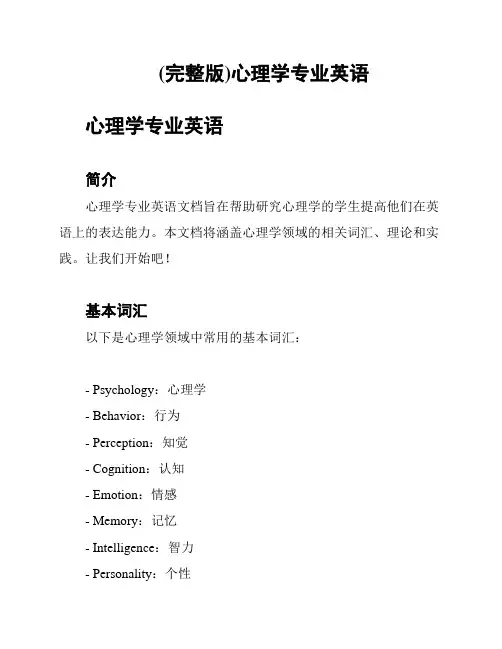
(完整版)心理学专业英语心理学专业英语简介心理学专业英语文档旨在帮助研究心理学的学生提高他们在英语上的表达能力。
本文档将涵盖心理学领域的相关词汇、理论和实践。
让我们开始吧!基本词汇以下是心理学领域中常用的基本词汇:- Psychology:心理学- Behavior:行为- Perception:知觉- Cognition:认知- Emotion:情感- Memory:记忆- Intelligence:智力- Personality:个性- Development:发展- Motivation:动机理论心理学涵盖了许多理论,以下是其中一些常见的心理学理论:1. 行为主义理论:行为主义认为行为是在环境刺激的影响下形成的,强调外部刺激对行为的影响。
2. 心理动力学理论:心理动力学理论关注潜意识和个人经验对行为的影响,强调个体内在的冲突和动机。
3. 认知心理学理论:认知心理学关注个体的思维过程和信息处理,强调思维、语言和决策对行为的影响。
4. 社会文化心理学理论:社会文化心理学关注社会和文化对行为的影响,强调个体和环境的互动。
实践心理学的实践包括以下几个方面:1. 临床心理学:临床心理学关注诊断和治疗心理问题,包括心理疾病和心理障碍。
2. 教育心理学:教育心理学关注研究和教育过程中的心理因素,帮助提高学生的研究成果和心理健康。
3. 社会心理学:社会心理学关注个体在社会环境中的行为和互动,研究社会认知、群体行为和人际关系。
4. 工业组织心理学:工业组织心理学关注组织中的心理因素,帮助提高工作效率和员工满意度。
希望这份文档能帮助您更好地理解心理学专业英语。
如有任何问题,请随时联系我们。
祝您学业进步!。

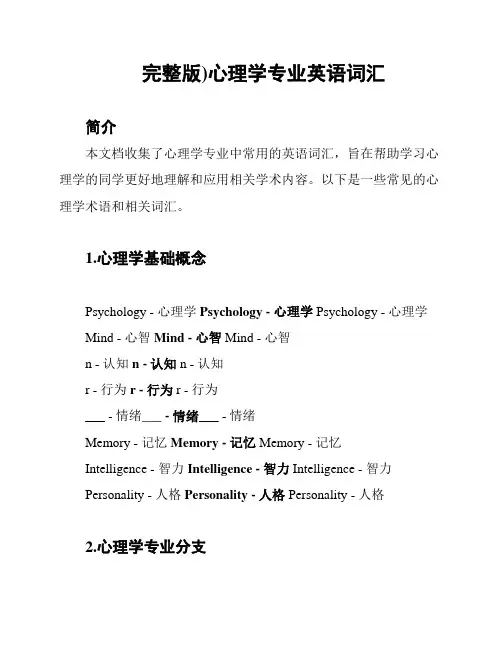
完整版)心理学专业英语词汇简介本文档收集了心理学专业中常用的英语词汇,旨在帮助学习心理学的同学更好地理解和应用相关学术内容。
以下是一些常见的心理学术语和相关词汇。
1.心理学基础概念Psychology - 心理学Psychology - 心理学Psychology - 心理学Mind - 心智Mind - 心智Mind - 心智n - 认知n - 认知n - 认知r - 行为r - 行为r - 行为___ - 情绪___ - 情绪___ - 情绪Memory - 记忆Memory - 记忆Memory - 记忆Intelligence - 智力Intelligence - 智力Intelligence - 智力Personality - 人格Personality - 人格Personality - 人格2.心理学专业分支___ - 发展心理学___ - 发展心理学___ - 发展心理学___ - 社会心理学___ - 社会心理学___ - 社会心理学___ - 认知心理学___ - 认知心理学___ - 认知心理学___ - 临床心理学___ - 临床心理学___ - 临床心理学___ - 教育心理学___ - 教育心理学___ - 教育心理学Industrial-___(I/O) Psychology - 工业组织心理学Industrial-___(I/O) Psychology - 工业组织心理学Industrial-___(I/O) Psychology - 工业组织心理学___ - 神经心理学___ - 神经心理学___ - 神经心理学3.心理学研究方法___ - 实验___ - 实验___ - 实验Survey - 调查Survey - 调查Survey - 调查n - 观察n - 观察n - 观察Interview - 访谈Interview - 访谈Interview - 访谈nnaire - 问卷nnaire - 问卷nnaire - 问卷n - 相关性n - 相关性n - 相关性Statistical Analysis - 统计分析Statistical Analysis - 统计分析Statistical Analysis - 统计分析Sample - 样本Sample - 样本Sample - 样本n - 总体n - 总体n - 总体4.心理学理论Psychoanalysis - 精神分析Psychoanalysis - 精神分析Psychoanalysis - 精神分析rism - 行为主义rism - 行为主义rism - 行为主义___ - 认知理论___ - 认知理论___ - 认知理论___ - 人本主义心理学___ - 人本主义心理学___ - 人本主义心理学___ - 生物心理学___ - 生物心理学___ - 生物心理学___ - 进化心理学___ - 进化心理学___ - 进化心理学Social learning theory - 社会学习理论Social learning theory - 社会学习理论Social learning theory - 社会学习理论5.心理学诊断和治疗方法Diagnosis - 诊断Diagnosis - 诊断Diagnosis - 诊断___ - 治疗___ - 治疗___ - 治疗Counseling - 咨询Counseling - 咨询Counseling - 咨询___ - 心理治疗___ - 心理治疗___ - 心理治疗___ - 药物治疗___ - 药物治疗___ - 药物治疗___ (CBT) - 认知行为疗法___ (CBT) - 认知行为疗法___ (CBT) - 认知行为疗法Group ___ - 团体疗法Group ___ - 团体疗法Group ___ - 团体疗法___ - 艺术疗法___ - 艺术疗法___ - 艺术疗法6.心理学实验设计Independent Variable - 自变量Independent Variable - 自变量Independent Variable - 自变量___ Variable - 因变量___ Variable - 因变量___ Variable - 因变量Control Group - 对照组Control Group - 对照组Control Group - 对照组Experimental Group - 实验组Experimental Group - 实验组Experimental Group - 实验组Random Assignment - 随机分配Random Assignment - 随机分配Random Assignment - 随机分配Single-Blind Study - 单盲研究Single-Blind Study - 单盲研究Single-Blind Study - 单盲研究Double-Blind Study - 双盲研究Double-Blind Study - 双盲研究Double-Blind Study - 双盲研究7.心理测量与评估Psychological Assessment - 心理测量Psychological Assessment - 心理测量Psychological Assessment - 心理测量Intelligence Test - 智力测试Intelligence Test - 智力测试Intelligence Test - 智力测试Personality Test - 人格测验Personality Test - 人格测验Personality Test - 人格测验Psychological Test - 心理测验Psychological Test - 心理测验Psychological Test - 心理测验Validity - 有效性Validity - 有效性Validity - 有效性Reliability - 可靠性Reliability - 可靠性Reliability - 可靠性___ - 标准化___ - 标准化___ - 标准化以上是一些常用的心理学专业英语词汇,希望对学习心理学的同学有所帮助。

心理学专业英语复习材料1. 心理学基础知识复
- 心理学的定义与研究范畴
- 心理学的主要流派和学派
- 心理学的发展历程和重要里程碑
- 心理学的研究方法和实验设计
2. 心理学研究领域复
- 认知心理学
- 发展心理学
- 社会心理学
- 临床心理学
- 教育心理学
- 工业与组织心理学
- 运动心理学
3. 心理学相关概念复
- 情绪与情感
- 感知与注意力
- 记忆与研究
- 人格与行为
- 心理健康与心理疾病
- 生理心理学与神经科学4. 心理学实践与应用复
- 心理评估与测量
- 心理治疗与咨询
- 教育与职业咨询
- 团队与领导力发展
- 心理学在医疗领域的应用5. 心理学专业英语复
- 心理学相关词汇与表达
- 心理学学术写作与阅读理解
- 心理学论文写作与格式要求
- 心理学研究报告与实验设计
以上是本文档的主要内容,希望对你的心理学专业英语复有所帮助。
祝你取得好成绩!
参考资料:。
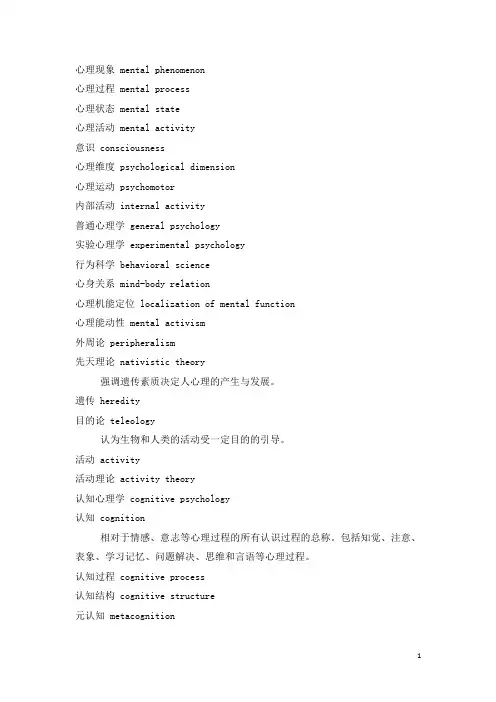
心理现象 mental phenomenon心理过程 mental process心理状态 mental state心理活动 mental activity意识 consciousness心理维度 psychological dimension心理运动 psychomotor内部活动 internal activity普通心理学 general psychology实验心理学 experimental psychology行为科学 behavioral science心身关系 mind-body relation心理机能定位 localization of mental function心理能动性 mental activism外周论 peripheralism先天理论 nativistic theory强调遗传素质决定人心理的产生与发展。
遗传 heredity目的论 teleology认为生物和人类的活动受一定目的的引导。
活动 activity活动理论 activity theory认知心理学 cognitive psychology认知 cognition相对于情感、意志等心理过程的所有认识过程的总称。
包括知觉、注意、表象、学习记忆、问题解决、思维和言语等心理过程。
认知过程 cognitive process认知结构 cognitive structure元认知 metacognition认知失调 cognitive dissonance认知地图 cognitive map认知技能 cognitive skill认知方式 cognitive style信息 information信息论 information theory信息加工 information processing信息加工心理学 information processing psychology 信息加工理论 information processing theory信息加工模型 information processing model中央处理器模型 central processor model信息储存 information storage信息提取 information retrieval人工智能 artificial intelligence, AI计算机类比 computer analogy计算机模拟 computer simulation计算机模型 computer model唯心主义心理学 idealistic psychology意动心理学 act psychology唯意志论 voluntarism唯灵论 spiritualism强调超自然精神作用。
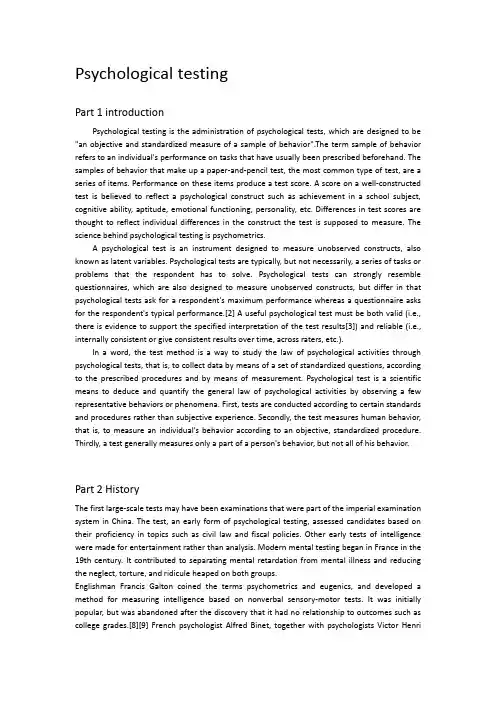
Psychological testingPart 1 introductionPsychological testing is the administration of psychological tests, which are designed to be "an objective and standardized measure of a sample of behavior".The term sample of behavior refers to an individual's performance on tasks that have usually been prescribed beforehand. The samples of behavior that make up a paper-and-pencil test, the most common type of test, are a series of items. Performance on these items produce a test score. A score on a well-constructed test is believed to reflect a psychological construct such as achievement in a school subject, cognitive ability, aptitude, emotional functioning, personality, etc. Differences in test scores are thought to reflect individual differences in the construct the test is supposed to measure. The science behind psychological testing is psychometrics.A psychological test is an instrument designed to measure unobserved constructs, also known as latent variables. Psychological tests are typically, but not necessarily, a series of tasks or problems that the respondent has to solve. Psychological tests can strongly resemble questionnaires, which are also designed to measure unobserved constructs, but differ in that psychological tests ask for a respondent's maximum performance whereas a questionnaire asks for the respondent's typical performance.[2] A useful psychological test must be both valid (i.e., there is evidence to support the specified interpretation of the test results[3]) and reliable (i.e., internally consistent or give consistent results over time, across raters, etc.).In a word, the test method is a way to study the law of psychological activities through psychological tests, that is, to collect data by means of a set of standardized questions, according to the prescribed procedures and by means of measurement. Psychological test is a scientific means to deduce and quantify the general law of psychological activities by observing a few representative behaviors or phenomena. First, tests are conducted according to certain standards and procedures rather than subjective experience. Secondly, the test measures human behavior, that is, to measure an individual's behavior according to an objective, standardized procedure. Thirdly, a test generally measures only a part of a person's behavior, but not all of his behavior.Part 2 HistoryThe first large-scale tests may have been examinations that were part of the imperial examination system in China. The test, an early form of psychological testing, assessed candidates based on their proficiency in topics such as civil law and fiscal policies. Other early tests of intelligence were made for entertainment rather than analysis. Modern mental testing began in France in the 19th century. It contributed to separating mental retardation from mental illness and reducing the neglect, torture, and ridicule heaped on both groups.Englishman Francis Galton coined the terms psychometrics and eugenics, and developed a method for measuring intelligence based on nonverbal sensory-motor tests. It was initially popular, but was abandoned after the discovery that it had no relationship to outcomes such as college grades.[8][9] French psychologist Alfred Binet, together with psychologists Victor Henriand Théodore Simon, after about 15 years of development, published the Binet-Simon test in 1905, which focused on verbal abilities. It was intended to identify mental retardation in school children.The origins of personality testing date back to the 18th and 19th centuries, when personality was assessed through phrenology, the measurement of the human skull, and physiognomy, which assessed personality based on a person's outer appearances.These early pseudoscientific techniques were eventually replaced with more empirical methods in the 20th century. One of the earliest modern personality tests was the Woolworth Personality Data Sheet, a self-report inventory developed for World War I and used for the psychiatric screening of new draftees.Part 3 Characteristics of tests◆ 1. According to the explicit behavior of the subjects, infer their internal psychologicalprocess or psychological characteristics, so the psychological and educational test is a scientific research form of "result" for "cause", so it is indirect.◆ 2. relativity. The results measured by the Mental and Educational Test Scale generally reflectindividual differences only from the ranking order. Therefore, scientifically speaking, the results of psychological and educational tests are only a relative quantity, compared with the behavior of the majority of the subjects in the group or some artificially determined criteria.◆ 3. objectivity. Although psychological and educational tests are indirect and relative, theystill have objectivity.Part 4 PrinciplesProper psychological testing consists of the following:●Standardization - All procedures and steps must be conducted with consistency and underthe same environment to achieve the same testing performance from those being tested.●Objectivity - Scoring such that subjective judgments and biases are minimized, with resultsfor each test taker obtained in the same way.●Test Norms - The average test score within a large group of people where the performanceof one individual can be compared to the results of others by establishing a point of comparison or frame of reference.●Reliability - Obtaining the same result after multiple testing.●Validity - The type of test being administered must measure what it is intended to measure.Part 5 Types(1) classification by function.➢ 1.Ability test -- practical ability and potential ability.➢ 2. achievement test - academic achievement➢ 3. Personality test -personality, temperament, interest, attitude and other psychological characteristics(2)Classification by test methodIndividual tests.➢Advantages: it can control the speech and mood and behavioral responses of the subjects. Such➢Disadvantages: time consuming and arduous. The main trial is strict. SuchGroup test.➢Advantages: save time and effort, and collect data in a short time. It➢Disadvantages: it is not easy to control the behavior of subjects, and it is easy to produce errors.(3) Classification by test materials➢Written test (paper and pencil test)➢Non-verbal test(4) Classification by test purposes1.Descriptive test. The purpose is to describe the ability, personality and othercharacteristics of an individual or group.2.Diagnostic test. The purpose is to diagnose a behavioral problem in an individualor group.3.Predictive test. The goal is to predict individual future performance and the levelthat can be achieved.(5)according to the application of the testcation test.2.Career tests.3.Clinical test.◆IQ/achievement testsIQ tests purport to be measures of intelligence, while achievement tests are measures of the use and level of development of use of the ability. IQ (or cognitive) tests and achievement tests are common norm-referenced tests. In these types of tests, a series of tasks is presented to the person being evaluated, and the person's responses are graded according to carefully prescribed guidelines. After the test is completed, the results can be compiled and compared to the responses of a norm group, usually composed of people at the same age or grade level as the person being evaluated. IQ tests which contain a series of tasks typically divide the tasks into verbal (relying on the use of language) and performance, or non-verbal (relying on eye–hand types of tasks, or use of symbols or objects). Examples of verbal IQ test tasks are vocabulary and information (answering general knowledge questions). Non-verbal examples are timed completion of puzzles (object assembly) and identifying images which fit a pattern (matrix reasoning).IQ tests (e.g., WAIS-IV, WISC-V, Cattell Culture Fair III, Woodcock-Johnson Tests of Cognitive Abilities-IV, Stanford-Binet Intelligence Scales V) and academic achievement tests(e.g. WIAT, WRAT, Woodcock-Johnson Tests of Achievement-III) are designed to beadministered to either an individual (by a trained evaluator) or to a group of people (paper and pencil tests). The individually administered tests tend to be more comprehensive, more reliable, more valid and generally to have better psychometric characteristics than group-administered tests. However, individually administered tests are more expensive toadminister because of the need for a trained administrator (psychologist, school psychologist, or psychometrician).◆Personality testsPsychological measures of personality are often described as either objective tests or projective tests.1.Objective tests have a restricted response format, such as allowing for true or false answers or rating using an ordinal scale. Prominent examples of objective personality tests include the Minnesota Multiphasic Personality Inventory, Millon Clinical Multiaxial Inventory-IV,[12] Child Behavior Checklist,[13] Symptom Checklist 90[14] and the Beck Depression Inventory.[15] Objective personality tests can be designed for use in business for potential employees, such as the NEO-PI, the 16PF, and the OPQ (Occupational Personality Questionnaire), all of which are based on the Big Five taxonomy. The Big Five, or Five Factor Model of normal personality, has gained acceptance since the early 1990s when some influential meta-analyses (e.g., Barrick & Mount 1991) found consistent relationships between the Big Five personality factors and important criterion variables.Another personality test based upon the Five Factor Model is the Five Factor Personality Inventory – Children (FFPI-C.).[16]2.Projective tests(Free response measures) allow for a freer type of response. An example of this would be the Rorschach test, in which a person states what each of ten ink blots might be.The most widely used scoring system for the Rorschach is the Exner system of scoring.[18] Another common projective test is the Thematic Apperception Test (TAT),[19] which is often scored with Westen's Social Cognition and Object Relations Scales[20] and Phebe Cramer's Defense Mechanisms Manual.[21] Both "rating scale" and "free response" measures are used in contemporary clinical practice, with a trend toward the former.Other projective tests include the House-Tree-Person test, the Animal Metaphor Test.◆Other testingin addition to the competence test and personality test described above, the psychological and educational tests also include achievement test, needs test, attitude test, interest test, mental health test, interpersonal relationship test and so on.1.Edward's personal preference scale (EPPS)2.SIMH competition self rating health Checklist (SCL - 90)Part6 Use of tests⏹First, do a good job of preparation before the test, including familiarity with the testmanual, especially the instructions and materials required for the test.⏹Second, choose the appropriate test environment, generally for the daily work orlearning environment, such as students in the classroom to test, while trying to eliminate all interference.⏹Thirdly, the test should be carried out strictly according to the standardized guidelinesand the standard time limit, and should not be changed at will without special circumstances.Fourth, establish a good trust and interpersonal relationship with the subjects, obtain the cooperation of the subjects, and ensure the effectiveness of the test.Part 7 Interpreting scoresPsychological tests, like many measurements of human characteristics, can be interpreted ina norm-referenced or criterion-referenced manner. Norms are statistical representations ofa population. Norms are available for standardized psychological tests, allowing for anunderstanding of how an individual's scores compare with the group norms. A criterion-referenced interpretation of a test score compares an individual's performance to some criterion other than performance of other individuals.In a word, the test method is a way to study the law of psychological activities through psychological tests, that is, to collect data by means of a set of standardized questions, according to the prescribed procedures and by means of measurement. Psychological test is a scientific means to deduce and quantify the general law of psychological activities by observing a few representative behaviors or phenomena. First, tests are conducted according to certain standards and procedures rather than subjective experience. Secondly, the test measures human behavior, that is, to measure an individual's behavior according to an objective, standardized procedure. Thirdly, a test generally measures only a part of a person's behavior, but not all of his behavior.。
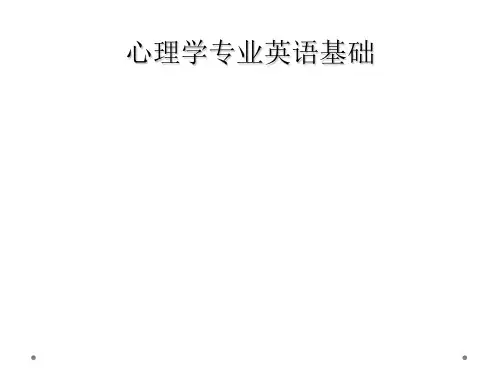
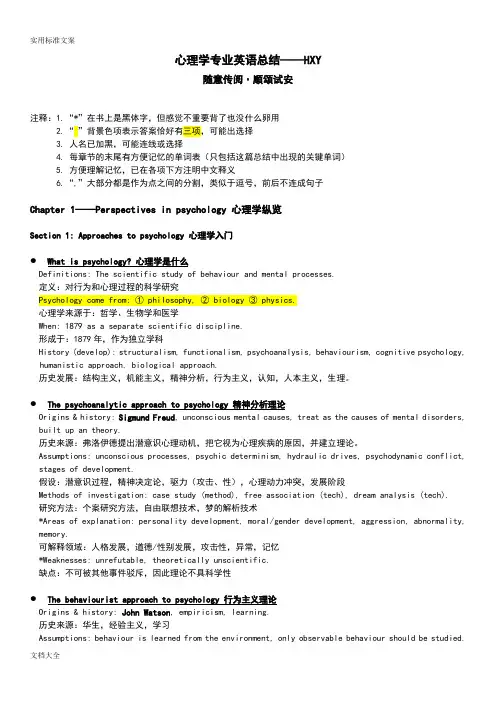
心理学专业英语总结——HXY随意传阅·顺颂试安注释:1.“*”在书上是黑体字,但感觉不重要背了也没什么卵用2.“”背景色项表示答案恰好有三项,可能出选择3. 人名已加黑,可能连线或选择4. 每章节的末尾有方便记忆的单词表(只包括这篇总结中出现的关键单词)5. 方便理解记忆,已在各项下方注明中文释义6.“,”大部分都是作为点之间的分割,类似于逗号,前后不连成句子Chapter 1——Perspectives in psychology 心理学纵览Section 1: Approaches to psychology 心理学入门●What is psychology? 心理学是什么Definitions: The scientific study of behaviour and mental processes.定义:对行为和心理过程的科学研究Psychology come from: ① philosophy, ② biology ③ physics.心理学来源于:哲学、生物学和医学When: 1879 as a separate scientific discipline.形成于:1879年,作为独立学科History (develop): structuralism, functionalism, psychoanalysis, behaviourism, cognitive psychology, humanistic approach, biological approach.历史发展:结构主义,机能主义,精神分析,行为主义,认知,人本主义,生理。
●The psychoanalytic approach to psychology 精神分析理论Origins & history: Sigmund Freud, unconscious mental causes, treat as the causes of mental disorders, built up an theory.历史来源:弗洛伊德提出潜意识心理动机,把它视为心理疾病的原因,并建立理论。
心理学专业英语考试(答案见尾页)一、选择题1. 什么是心理学?A. 心理学是一门研究人类心理现象及其影响下的精神功能和行为活动的科学。
B. 心理学是研究个体和群体行为及精神过程的科学。
C. 心理学是研究人类思维和行为的科学。
D. 心理学是研究生物体的生理和心理过程的科学。
2. 心理学的主要分支有哪些?A. 生物心理学B. 认知心理学C. 发展心理学D. 社会心理学3. 什么是潜意识?A. 潜意识是指那些在意识中未被察觉到的心理过程。
B. 潜意识是指那些在意识中已被察觉到的心理过程。
C. 潜意识是指那些在无意识中储存的心理过程。
D. 潜意识是指那些在无意识中被唤醒的心理过程。
4. 什么是认知失调?A. 认知失调是指一个人的行为与自己先前一贯的对自我的认知(通常是正面的、积极的自我形象)产生分歧,从一个认知推断出另一个对立的认知时而产生的不舒适感、不愉快的情绪。
B. 认知失调是指两个人的行为与自己先前一贯的对自我的认知(通常是正面的、积极的自我形象)产生分歧,从一个认知推断出另一个对立的认知时而产生的不舒适感、不愉快的情绪。
C. 认知失调是指三个人的行为与自己先前一贯的对自我的认知(通常是正面的、积极的自我形象)产生分歧,从一个认知推断出另一个对立的认知时而产生的不舒适感、不愉快的情绪。
D. 认知失调是指四个人的行为与自己先前一贯的对自我的认知(通常是正面的、积极的自我形象)产生分歧,从一个认知推断出另一个对立的认知时而产生的不舒适感、不愉快的情绪。
5. 什么是弗洛伊德的精神分析理论?A. 弗洛伊德的精神分析理论认为人的精神活动的能量来源于本能,本能分为两类:生命本能与死亡本能。
B. 弗洛伊德的精神分析理论认为人的精神活动的能量来源于自我,自我是人格中的主导力量。
C. 弗洛伊德的精神分析理论认为人的精神活动的能量来源于本我,本我遵循快乐原则。
D. 弗洛伊德的精神分析理论认为人的精神活动的能量来源于超我,超我遵循道德原则。
心理学专业英语总结——HXY随意传阅·顺颂试安注释:1、“*”在书上就是黑体字,但感觉不重要背了也没什么卵用2、“”背景色项表示答案恰好有三项,可能出选择3、人名已加黑,可能连线或选择4、每章节得末尾有方便记忆得单词表(只包括这篇总结中出现得关键单词)5、方便理解记忆,已在各项下方注明中文释义6、“,”大部分都就是作为点之间得分割,类似于逗号,前后不连成句子Chapter 1——Perspectives in psychology 心理学纵览Section 1: Approaches to psychology 心理学入门●What is psychology? 心理学就是什么Definitions: The scientific study of behaviour and mental processes、定义:对行为与心理过程得科学研究Psychology e from: ①philosophy, ②biology ③physics、心理学来源于:哲学、生物学与医学When: 1879 as a separate scientific discipline、形成于:1879年,作为独立学科History (develop): structuralism, functionalism, psychoanalysis, behaviourism, cognitive psychology, humanistic approach, biological approach、历史发展:结构主义,机能主义,精神分析,行为主义,认知,人本主义,生理。
●The psychoanalytic approach to psychology 精神分析理论Origins & history: Sigmund Freud, unconscious mental causes, treat as the causes of mental disorders, built up an theory、历史来源:弗洛伊德提出潜意识心理动机,把它视为心理疾病得原因,并建立理论。
心理学专业英语词汇(N1)心理学专业英语词汇(N1)心理学专业英语词汇(N1)n 舌咽神经n 符节说n 脑的三个基本机能联合区n factor n 因素n factor 数字运算因素n of group) 群体多层观察系统n ⅰ嗅神经n ⅱ视神经n ⅲ动眼神经n ⅳ滑车神经n ⅴ三叉神经n ⅵ外展神经n ⅶ面神经n ⅷ听神经n ⅹ迷走神经n ? 副神经n ? 舌下神经nafta 北美自由贸易协定nagel chart test 纳格尔图片测验nagel s test 纳格尔色盲测验nail biting 咬指甲癖naive 朴素的naive anthropomorphism 素朴拟人论naive anthropomorphism 幼稚拟人论naive materialism 素朴唯物论naive positivism 素朴实证主义naive psychology 通俗心理学nalliplex character 无显特性nalorphine 丙烯去甲吗啡named scribble stage 涂绘命名期naming 命名naming stage 命名期nancy school 南锡学派nanism 侏儒症nano 毫微nanometer 毫微米nanosecond 毫微秒nanosomia 侏儒症nanosomus 侏儒nanounit 毫微单位nanous 矮小的napkin ring figure 餐巾环形图napkin ring figure 多义图形narcism 恋己癖narcismus 自体观窥欲narcissism 自爱欲narcissism of small difference 对微小差异的自恋narcissist 自恋者narcissistic alliance 自恋联结narcissistic equilibrium 自我均衡narcissistic libido 自恋欲力narcissistic neurosis 自恋神经症narcissistic personality 自恋人格narcissistic personality disorder 自是型人格障碍narcoanalysis 麻醉分析narcohepnia 乍醒麻木narcohypnosis 麻醉药催眠narcointerview 麻醉面谈narcolepsy 发作性睡眠症narcoma 麻醉性昏睡narcomania 麻醉药癖narcose 麻醉状态的narcosis 麻醉narcostimulant 麻醉兴奋性的narcosynthesis 麻醉综合法narcotherapy 麻醉疗法narcotic 麻醉的narcotic antagonist 抗麻醉剂narcotic phase 麻醉相narcotico irritant 麻醉剌激性的narcotics 麻醉剂narcotics abuse 麻醉剂滥用narcotism 麻醉状态narcotization 麻醉法narcotize 使麻醉narcous 麻醉状态的narco analysis method of interrogation 麻醉分析讯问法narrow band syndromes 窄义综合症narrow categorizing style 细密型narrowing movement 退缩运动narrow band syndrome scales 窄义综合症量表narrow external attentionnarrow internal attentionnasal cavity 鼻腔nasal retina 鼻半侧视网膜nasality 鼻音性nascence 发生nascent 初生的nascent 发展初期的nastic 感性的nastic movement 感性运动nasty 感性natality 出生率natality statistics 出生率统计national assessment of educational progress 美国家教育进步评测national association for the study of epilepsy 美全国癫痫研究协会national character 国民性national committee for mental health 美全国心理卫生委员会national committee for mental hygiene 美全国精神卫生协会national conditions 民情national consciousness 民族意识national council of measurement in education 美全国教育测验协会美全国教育测验协会national culture 民族文化national ethics 国家伦理national form 民族形式national identity 国民同一性national institute of mental health 美国家心理卫生研究所national institute of neurological diseases and blindness 美全国神经病和盲症学会national intelligence test 国民智力测验国民智力测验national language 国语national norm 全国常模national prejudice 民族偏见national society for crippled children 美全国残疾儿童协会national society for the prevention of cruelty to children 美全国防止虐待儿童协会national spirit 民族精神national standard 国家标准national stereotype 国民刻板印象national survey 国家调查national traits 民族性nationalism 民族主义nationality 国籍nationality 民族性nationwide sampling survey 全国性抽样调查native 先天的native behavior 先天性行为native endowment 先天禀赋native equipment 天资native language 本族语native power 天赋聪明native reaction 先天反应native traits 天赋特质nativism 先天论nativism empiricism controversy 先天与经验争议nativistic theory 天赋学说natural 自然的natural ability 本能natural affections 自然的感情natural agency 自然力natural agent 自然力natural beauty 自然美natural childbirth 自然生育法natural classification 自然分类natural color system 自然颜色系统natural concept 自然概念natural conjugate distribution 自然共轭分布natural developing theory of learning 学习的自然展开说natural dialectics 自然辩证法natural disasters 自然灾害natural endowment 先天禀赋natural environment 自然环境natural experiment 自然实验natural feeling 自然的感情natural fertility 自然生育率natural fitness 自然的合理性natural form 自然形式natural gender 自然性natural group design 自然组设计natural inclinations 自然素质natural increase 自然增加natural instincts 天性natural language 自然语言natural law 自然法则natural lighting 自然采光natural method 自然教育法natural monism 自然一元论natural motion 自然运动natural object 自然物体natural observation 自然观察natural phenomena 自然现象natural place 自然位置natural population 自然群体natural predisposition 先天素因natural punishment 自然惩罚natural radioactive decay 自然衰变natural regeneration 自然更新natural relation 自然关系natural science 自然科学natural science psychology 自然科学心理学natural selection 自然选择natural selectionist 自然选择论者natural sleep 自然睡眠natural succession 自然演替natural talent 自然禀赋natural tendency 自然趋势natural wet bulb temperature 自然湿球温度natural world 物质世界naturalism 自然主义naturalistic observation 自然观察naturalistic observation method 自然观察法naturality 自然性naturalized 驯化的naturalness 自然状态nature 天性nature 自然nature concept 自然概念nature homosexual period 自然同性恋期自然同性恋期nature of consciousness 意识的性质nature of self 自我的性质nature study 自然研究nature worship 自然祟拜nature nurture 先天与后天nature nurture controversy 天性与教养争议nature nurture problemnaturism 自然崇拜naturopathy 物理治疗nausea 恶心nauseate 厌恶nauseous 腐臭nauseous 令人恶心的nauta gygax methodncs 自然颜色系统nealogy 幼动物学neanic 幼年的near orientation 近定向near point 近点nearest neighbor frequency 最近邻频率最近邻频率nearest neighbor method 最近邻法nearness 接近度near sightedness 近视necessary 必然的necessary being 必然存在necessary cause 必然理由necessary condition 必然条件necessary connection 必然联系necessity 必然性neck circumference 颈围neck reflex 颈反射necker cube 内克尔立方体necrology 死亡统计necromania 恋尸癖necrometer 尸体测量器necromimesis 死亡妄想necrophagia 食尸癖necrophagy 食尸癖necrophile 恋尸癖者necrophilia 恋尸癖necrophilious 恋尸癖的necrophobia 尸体恐怖症necrophobia 死亡恐怖necropsy 尸体剖检necropsy 验尸ned 无疾病迹象need 需要need analysis 需要分析need cathexis 需求投注need for a frame of orientation 定向需求定向需求need for abasement 谦卑需求need for achievement 成就需求need for affection 情感需要need for affiliation 归属需要need for affiliation 亲合需要need for aggression 攻击需求need for approval 认可需求need for approval 赞许需求need for autogenic 自主需求need for autonomy 自立需求need for change 革新需求need for deference 顺从需求need for endurance 持久需求need for exhibition 表现需求need for heterosexuality 爱恋需求need for independence 独立需求need for nurturance 抚助需求need for order 秩序需求need for positive regard 正面关注需求正面关注需求need for power 权力需要need for punishment 惩罚需求need for relatedness 相属需求need for self actualization 自我实现的需要need for transcendence 超越需求need for understanding 知之需求need gratification 需求满足need hierarchy theory 需要层次论need integrate 需求综合need of affiliation 亲和需求need of interception 省察需求need of rootedness 生根需求need patter 需求范型need reduction theory 需求削减论need satisfaction 需求满足need state 需求状态need system 欲求系统need tension 需求性紧张need theory of crime 需求论犯罪观needarousal 需求激发needle electrode 针状电极needy child 贫困儿童need complementarity hypothesis 需求互补假说need drive incentive hypothesis 需求驱力诱因假说need drive incentive pattern 需求驱力诱因模式need persistence 需求持续性need press 迫切需求need press theory 需求压力论neef s hammer 内夫锤neencephalon 新脑negation 否认negation 抗拒性negative acceleration 负加速negative adaptation 负适应negative adaptation 消极适应negative adjustment 消极调整negative afterpotential 负后电位negative after effect 负后效negative after image 负后象negative association 负相联negative attention seeking 消极型引人注意negative attitude 消极态度negative attitude change 态度负向改变态度负向改变negative behavior 消极行为negative binomial distribution 负二项分布negative case analysis 负性个案分析negative cathexis 消极投注negative conditioned reflex 阴性条件反射negative contrast 负对比negative contrast of reinforcement 强化负对比negative control 负控制negative correlation 负相关negative cue 负线索negative definition 否定的定义negative diagnosis 消极诊断negative difference 负差negative direction 反方向negative discipline 消极训练negative equilibrium 消极平衡negative error 负误差negative exercise 消极练习negative feedback 负反馈negative fixation 消极性固着negative focusing 负聚焦negative hallucination 负幻觉negative identity 反向认同negative identity 消极统合negative incentive 负诱因negative inducement 负诱导negative induction 负诱导negative influence 消极作用negative instance 否定实例negative integer 负整数negative interaction 负相互作用negative interest 消极兴趣negative interference 负干扰negative item 负向题目negative judgment 否定判断negative law of effect 负效果律negative linear relationship 负线性关系negative nothing 消极的空无negative number 负数negative peak 最大负值negative phototaxis 负向光性negative phototropism 负向光性negative practice 反练习negative practice 消极练习negative punishment 负效惩罚negative reactive 负性反应negative recency effect 负性新近效应negative recollection 消极回忆negative regency 时近负效应negative reinforcement 负强化negative reinforcer 负强化物negative reinforcing stimulus 负强化刺激负增强刺激negative resistance 负阻negative response 负反应negative response 消极反应negative reward 负奖赏negative self feeling 消极自感negative sign 负量negative skewness 负偏态negative stage 反抗期negative stem 负题根negative stem item 具负题根试题negative stimulus 负性刺激negative suggestion 消极暗示negative symptom 负性症状negative term 负项negative time error 负时间误差negative transfer 负迁移negative transference 负移情negative tropism 负感应性negative valence 负价negatively accelerated curve 负加速曲线negative negative conflictnegative state relief hypothesis 消极心境解脱说negativism 否定论negativism 违拗症negativity 否定性neglect 忽视neglected variables 忽略的变量negotiation 谈判neighborhood model 邻式模型neiman pick s diseasenelson biology test 纳尔逊生物测验nelson denny reading test 纳丹二氏阅读测验nematoblast 精子细胞nembutal 戊巴比妥钠neobiogenesis 新生源说neocategory 新范畴neocerebellum 新小脑neocinetic 新运动区的neocortex 新皮层neofetal 幼胎的neofetus 幼胎neoformation 新生物neogala 初乳neogene 新第三纪neogenesis 新生neokinetic 新运动区的neolallia 新器官neologism 新器官neonatal 新生期的neonatal behavior assessment scale 新生儿行为评价量表neonatal chromosome disorder 新生儿染色体异常neonatal development 新生儿发育neonatal disorder 新生儿异常neonatal period 新生儿期neonatal reflex 新生儿反应neonate 新生儿neonate psychology 新生儿心理学neonatology 新生儿科学neopallium 新皮层neophobia 新奇恐怖症neophrenia 儿童期精神病neoplasma 赘生物neopositivism 新实证主义neopositivist 新实证主义者neopsychoanalytic school 新精神分析学派neoretinene 新视黄醛neostigmine 副交感神经兴奋剂neoteinia 幼态持续neoteny 幼态持续neothalamus 新丘脑neovitalism 新活力论neovitalist 新生机论者neozoic 新生代的neo behaviorism 新行为主义neo cortex 新皮质neo darwinism 新达尔文主义neo encephalon 新脑neo epigenesis 新渐成说neo evolution 新进化论neo freudian 新佛洛伊德学派neo freudism 新佛洛伊德主义neo humanism 新人本主义neo idealism 新唯心主义neo lamarckism 新拉马克主义neo malthusianism 新马尔萨斯主义neo platonism 新柏拉图主义neo psychoanalysis 新精神分析论nepenthe 使人忘忧的东西nepenthic 忘忧的nephelopsychosis 恋云癖nerve 神经nerve 勇敢nerve accommodation 神经适应nerve action 神经活动nerve block 神经阻断nerve bundle 神经束nerve cell 神经细胞nerve centre 神经中枢nerve chain 神经链nerve conduction 神经传导nerve conduction velocity 神经传导速率神经传导速率nerve cord 神经索nerve corpuscles 神经膜细胞nerve deafness 神经性耳聋nerve ending 神经末梢nerve fiber 神经纤维nerve fibril 神经纤维nerve gas 神经毒气nerve growth factor 神经原生长因子nerve impulse 神经冲动nerve layer 神经层nerve net 神经网nerve node 神经节nerve papilla 神经乳头nerve pattern 神经类型nerve plexus 神经丛nerve process 神经过程nerve regeneration 神经再生nerve ring 神经环nerve root 神经根nerve sheath 神经鞘nerve tract 神经通路nerve transmitter 神经介质nerve trigeminal 三叉神经nerve trunk 神经干nervi 神经nervi accessories 副神经nervi cerebrales 脑神经nervi facials 面神经nervi glossopharyngeus 舌咽神经nervi hypoglossus 舌下神经nervi nervorum 神经鞘神经nervi oculomotorius 动眼神经nervi olfactorius 嗅神经nervi olfactory 嗅神经nervi optics 视神经nervi spinales 脊神经nervi statoacusticus 位听神经nervi thoracales anteriores 胸前神经nervi thoracales posteriores 胸后神经nervi trigeminus 三叉神经nervi vagus 迷走神经nervimotility 神经运动力nervimotion 神经兴奋性运动nervimotor 运动神经的nervimuscular 神经肌肉的nervism 神经论nervosis 神经衰弱nervosity 神经质nervous 神经的nervous anorexia 神经性厌食症nervous breakdown 精神崩溃nervous crest 神经脊nervous disposition 神经质nervous excitation 神经兴奋nervous impulse 神经冲动nervous irritability 神经应激性nervous layer 神经层nervous process 神经过程nervous ramification 神经分枝nervous reaction 紧张反应nervous stimulant 神经兴奋剂nervous system 神经系统nervous system disorder 神经系统失常神经系统失常nervous system type 神经系统类型nervous temperament 神经质nervous type 神经类型nervousness 神经过敏nervousness in sports 运动性紧张nervousness of motivation 动因性紧张nervous humoral regulationnervus 神经nervus abducens 外展神经nervus accessorius 副神经nervus acusticus 听神经nervus auditorius 听神经nervus auricularis internus 耳内神经nervus auricularis magnus 耳大神经nervus auricularis posterior 耳后神经nervus auriculotemporalis 耳颞神经nervus buccinatorius 颊神经nervus cardiacus 心神经nervus centralis 中枢神经nervus centrifugalis 传出神经nervus centripetalis 传入神经nervus cerebrospinalis 脑脊神经nervus ciliaris 睫神经nervus cochleae 耳蜗神经nervus cutaneus 皮神经nervus facialis 面神经nervus frontalis 额神经nervus glossopharyngeus 舌咽神经nervus gustatorius 味神经nervus hypoglossus 舌下神经nervus infraorbitalis 眶下神经nervus infratrochlearis 滑车下神经nervus intermedius 中间神经nervus labialis 唇神经nervus lacrimalis 泪腺神经nervus laryngeus inferior 喉下神经nervus laryngeus recurrens 喉返神经nervus laryngeus superior 喉上神经nervus lingualis 舌神经nervus mandibularis 下颌神经nervus meningeus 脑膜神经nervus motorius 运动神经nervus ocularis 眼神经nervus oculomotorius 动眼神经nervus olfactorius 嗅神经nervus ophthalmicus 眼神经nervus opticus 视神经nervus parasympatheticus 副交感神经nervus peripheralis 外围神经nervus pharyngous 咽神经nervus pneumogastricus 迷走神经nervus preopticus 视前神经nervus recurrens 返神经nervus sensorius 感觉神经nervus stapedius 镫骨神经nervus statoacusticus 位听神经nervus sublingualis 舌下神经nervus subpharyngealis 咽下神经nervus supraorbitalis 眶上神经nervus supratrochlearis 滑车上神经nervus sympatheticus 交感神经nervus tegumentalis 皮神经nervus thalamicus 丘神经nervus trigeminalis 三叉神经nervus trigeminus 三叉神经nervus tympanicus 鼓室神经nervus vagus 迷走神经nervus vestibularis 前庭神经nervus vestibuli 前庭神经nervus visceralis 内脏神经nest building 巢居nest building 筑巢nested design 分隔实验设计nested factor 套因子nesting 筑巢net 净net 网net assimilation 净同化net correlation 净相关net correlation coefficient 净相关系数network 网络network model 网络模型network of artificial neurons 人造神经元网络network theorem 网状结构定理network therapy 网络疗法neu 神经膜neu 神经鞘neurad 向神经neural 神经的neural activity 神经活动neural analyzer 神经分析器neural canal 神经管neural circuit 神经回路neural coding 神经编码neural computation 神经计算neural deafness 神经性聋neural discharge 神经放电neural encoding 神经编码过程neural epithelium 神经上皮neural excitation 神经兴奋neural facilitation 神经易化neural fold 神经褶neural foramen 神经孔neural ganglia 神经节neural groove 神经沟neural impulse 神经冲动neural junction 神经连接neural latency 神经潜伏期neural lesion 神经损伤neural noise 神经噪声neural plate 神经板neural quantum theory 神经量子理论neural receptor 神经接受器neural reinforcement 神经强化neural ridge 神经褶neural rivalry 神经对抗neural switching 神经接通neural tube 神经管neuralgia 神经痛neural displacement theory of illusion 错觉的神经移位说neuramebimeter 神经反应时测定计neuranagenesis 神经再生neurapophysis 神经突neurapraxia 机能性麻痹neurapraxia 神经失用症neurarchy 神经控制作用neurasthenia 神经衰弱neurastheniac 神经衰弱患者neurasthenic neurosis 神经衰弱官能症神经衰弱官能症neurataxia 神经衰弱neuratrophia 神经萎缩neuraxis 神经轴neuraxon 神经轴neure 神经元neurectomy 神经切除术neurectopia 神经异位neurergic 神经作用的neurhypnology 催眠学neuriasis 癔病性疑病neuriatria 神经病疗法neuriatry 神经病疗法neuricity 神经力neuridin 脑胺neurilemma 神经膜neurility 神经性能neurimotility 神经运动力neurimotor 运动神经的neurine 神经碱neuritis 神经炎neuroallergy 神经变态反应性neuroanatomy 神经解剖学neurobiological approach 神经生理方法神经生理取向neurobiology 神经生物学neurobiology of learning and memory 学习与记忆神经生物学neuroblast 成神经细胞neuroblast 神经母细胞neuroceptor 神经受体neurochemical correlates 神经化学相关物neurochemistry 神经化学neurochoriditis 视神经脉络膜炎neurochorioretinitis 视神经脉络膜视网膜炎neurocirculatory 神经循环系统的neurocladism 神经分支新生neuroclonic 神经性痉挛的neurocoele 神经管腔neurocranium 脑颅neurocrine 神经内分泌的neurocrinia 神经性分泌作用neurocybernetics 神经控制论neurocyte 神经细胞neurocytology 神经细胞学neurodealgia 视网膜痛neurodeatrophia 视网膜萎缩neurodegenerative 神经变性的neurodendrite 树突neuroderm 神经外胚层neurodermatitis 神经性皮炎neurodiagnosis 神经病诊断neurodynamic 神经动力的neurodynamics 神经动力学neurodynia 神经痛neuroelectricity 神经电neuroelectrotherapy 神经病电疗法neuroembryology 神经胚胎学neuroencephalomyelopathy 神经脑脊髓病neuroendocrine 神经内分泌的neuroendocrine system 神经内分泌系统神经内分泌系统neuroendocrinology 神经内分泌学neuroethology 神经行为学neurofibril 神经元纤维neuroganglion 神经节neuroganglitis 神经节炎neurogen 神经元质neurogenesis 神经发生neurogenic 神经元的neurogenic tonus 神经元性紧张neuroglia 神经胶质neuroglia membrane 神经胶质膜neurogliocyte 神经胶质细胞neurography 神经论neuroheuristic programming 神经启发式程序neurohistology 神经组织学neurohormones 神经激素neurohumor 神经体液neurohumoral 神经体液的neurohumoral 神经元介质的neurohumoral regulation 神经体液调节神经体液调节neurohumoralism 神经元介质说neurohypnologist 催眠学家neurohypnology 催眠学neurohypophyseal hormone 垂体后叶激素neurohypophysis 垂体神经部neuroid 神经样的neuroinduction 神经诱导neuroinidia 神经细胞营养不良neurokyme 神经能neurolabyrinthitis 神经迷路炎neurolemma 神经膜neuroleptanalgesia 安定止痛法neuroleptic 抑制神经的neuroleptic drug 神经松弛药neuroleptics 神经松弛剂neuroleptoanalgesia 安定镇痛状态neurolinguistics 神经语言学neurological dysfunction 神经机能障碍神经机能障碍neurological mutant 神经突变型neurological substrate 神经底质neurologist 神经病学家neurology 神经学neurolysis 神经松解术neuromechanism 神经结构neuromimesis 模仿病neuromimetic 模仿病的neuromittor 神经传导器neuromotor 神经运动的neuromuscular 神经肌肉neuromuscular control system 神经肌肉控制系统neuromuscular disorder 神经肌肉障碍neuromuscular junction 神经肌肉接点神经肌肉接点neuromuscular unit 神经肌肉单位neuromyic 神经肌肉的neuron 神经元neuronagenesis 神经元发育不全neuronal dystrophy 神经元营养不良neuronatrophy 神经元萎缩neuronic equation 神经元方程式neuronitis 神经元炎neuronymy 神经命名法neuropapillitis 视神经炎neuroparalysis 神经性麻痹neuropath 神经病患者neuropathogenesis 神经病发病机理neuropathologist 神经病理学家neuropathology 神经病理学neuropathy 神经病neuropathy crime 神经症犯罪neuropharmacology 神经药理学neurophilic 向神经的neurophonia 叫喊性神经病neurophysiological mechanism 神经生理机制neurophysiology 神经生理学neuropile 神经纤维网neuropotential 神经电位neuropsychiatrist 神经精神病学家神经精神病学家neuropsychiatry 神经精神病学神经精神病学neuropsychic behavior 神经心理行为neuropsychological questionnaire 神经心理问卷neuropsychological test 神经心理测验neuropsychology 神经心理学neuropsychology abstracts神经心理学文摘neuropsychology review 神经心理学评论neuropsychopath 神经精神病neuropsychopharmacology 神经精神药理学neuroretinitis 视神经网膜炎neuroretinopathy 视神经网膜病neuroscience 神经科学neurosecretion 神经分泌neurosecretory cell 神经分泌细胞neurosis 神经官能症neurosis 神经症neurosism 神经衰弱neurosome 神经细胞体neurospasmus 神经性痉挛neurospongium 神经胶质neurospongium 神经纤维网neurostatus 神经系统状态neurosthenia 神经兴奋力过旺neurosyphilis 神经症系统梅毒neurotaxis 向神经性neuroterminal 神经终器neurotherapeutics 神经病疗法neurotherapy 神经病疗法neurotic 神经过敏neurotic anxiety 神经质焦虑neurotic attitudes 神经质态度neurotic behavior 神经质行为neurotic character 神经质性格neurotic coping 神经质的应对neurotic defense 神经质防卫neurotic depressive reaction 神经症抑郁反应neurotic mechanism of emotion 情绪的神经机制neurotic need 神经质需求neurotic personality 神经质人格neurotic resignation 神经型退避neurotic solution 神经质解脱neurotic trend 神经质趋向neurotica 神经机能病neuroticism 神经过敏症neurotmesis 神经断伤neurotomy 神经切断术neurotoxia 神经中毒症neurotoxic 神经中毒的neurotoxic substance 神经毒物neurotoxicity 神经中毒性neurotoxin 神经毒素neurotransmission 神经传递neurotransmitter 神经介质neurotransmitter system 神经介质系统神经传导物质系统neurotrophasthenia 神经系统营养不足神经系统营养不足neurotrophy 神经营养neurotypes 神经类型neurovisceral 脑脊髓交感神经系统的脑脊髓交感神经系统的neuro anatomy 神经解剖neuro biotaxis 神经细胞序列性neuro biotaxis 神经向性neuro chemical correlates 神经化学相关物neuro chemistry 神经化学neuro engineering 神经工程学neuro hormone 神经激素neuro humor 神经体液neuro linguistics 神经语言学neuro ophthalmology 神经眼科学neuro otology 神经耳科学neuro pathology 神经病理学neuro pattern 神经模式neuro pharmacology 神经药理学neuro physiology 神经生理学neuro vegetative 植物神经系统的neurula 神经胚neururgic 神经活动的neurypnology 催眠学neutral 中性的neutral impression 中性印象neutral point 中性点neutral reaction 中性反应neutral stimulus 中性刺激neutral theory 中性说neutral zone 中性区neutrality 中性neutralization 中性化neutropism 向神经性心理学专业英语词汇(N1) 相关内容:41。
心理学专业英语复习资料I. Translate the Following English Phrases into Chinese1. Research Methods 研究方法2. Psychophysics 心理物理学3. Theories of Learning 学习理论4. Social Cognition 社会认知5.Personality Test 人格测试6. Extraneous Variable 无关变量7. Longitudinal Study 纵向研究8. Crystallized Intelligence 晶体智力9. Motor control 运动控制10. Corpus Callosum 胼胝体11. Group Thinking 群体思维12. Social Loafing 社会懈怠13. Social Exchange 社会交换14. Social Approval 社会赞许15. Diffusion of Responsibility 责任分散16. Recency Effec 近因效应17.Trace Decay 痕迹消退18. Retrograde Amnesia 倒摄遗忘19. Social Support 社会支持20. Self-efficacy 自我效能21. Case Study 个案研究II. Translate the Following Chinese Word Groups into English1. 机能主义functionalism2. 自我实现self—actualization3.一般规律研究法nomothetic method4. 分层抽样stratified sampling5. 外在信度external reliability6. 选择性注意selective attention7. 知觉恒常性perceptual constancy8. 自我概念self concept9. 液体智力fluid intelligence10. 安全型依恋secure attachment11. 性别图示gender schema12. 亲社会行为pro social behavior13. 从众实验conformity experiment14. 头脑风暴brain storming15. 社会助长social facilitation16. 旁观者效应bystander effect17. 标准差standard deviation18. 柱状图bar chart19. 正态分布normal distribution20. 临界值critical value21. 知觉适应perceptual adaptationIII. Multiple Choices1. Like Carl Rogers, I believe people choose to live more creative and meaningful lives. My name isa. Wertheimer.b. Washburn.c. Skinner.d. Maslow.2. The goals of psychology are toa. develop effective methods of psychotherapy.b. describe, predict, understand, and control behavior.c. explain the functioning of the human mind.d. compare, analyze, and control human behavior.3. The "father" of psychology and founder of the first psychological laboratory wasa. Wilhelm Wundt.b. Sigmund Freud.c. John B. Watson.d. B. F. Skinner.4. You see a psychologist and tell her that you are feeling depressed. She talks to you about the goals you have for yourself, about your image of yourself, and about the choices that you make in your life and that you could make in your life. This psychologist would probably belong to the __________ school of psychology.a. humanisticb. psychodynamicc. behavioristicd. Gestalt5. Biopsychologistsa. limit the scope of their study to animals.b. are concerned with self-actualization and free will.c. stress the unconscious aspect of behavior.d. attempt to explain behavior in terms of biological or physical mechanisms.6. In a study of effects of alcohol on driving ability, the control group should be givena. a high dosage of alcohol.b. one-half the dosage given the experimental group.c. a driving test before and after drinking alcohol.d. no alcohol at all.7.The phrase "a theory must also be falsifiable" meansa. researchers misrepresent their data.b. a theory must be defined so it can be disconfirmed.c. theories are a rich array of observations regarding behavior but with few facts to support them.d. nothing.8. A common method for selecting representative samples is to select thema. randomly from the larger population.b. strictly from volunteers.c. by threatening or coercing institutionalized populations.d. from confidential lists of mail order firms.9. The chief function of the control group in an experiment is that ita. allows mathematical relationships to be established.b. provides a point of reference against which the behavior of the experimental group can be compared.c. balances the experiment to eliminate all extraneous variables.d. is not really necessary.10. Which of the following best describes a double-blind experimental procedure?a. All subjects get the experimental procedure.b. Half the subjects get the experimental procedure, half the placebo; which they receive is known only to the experimenter.c. Half the subjects get the experimental procedure, half the placebo; which they receive is not known to subjects or experimenters.d. All subjects get the control procedure.11. A simple experiment has two groups of subjects calleda. the dependent group and the independent group.b. the extraneous group and the independent group.c. the before group and the after group.d. the control group and the experimental group.12. One of the limitations of the survey method isa. observer bias.b. that it sets up an artificial situation.c. that replies may not be accurate.d. the self-fulfilling prophecy.13. To replicate an experiment means toa. use control groups and experimental groups.b. use statistics to determine the effect of chance.c. control for the effects of extraneous variables.d. repeat the experiment using either identical or improved research methods.14. Information picked up by the body's receptor cells is termeda. cognitionb. perception.c. adaptation.d. sensation.15. The incoming flow of information from our sensory systems is referred to asa. sensation.b. perception.c. adaptation.d. cognition.16. A researcher presents two lights of varying brightness to a subject who is asked to respond "same" or "different" by comparing their intensities. The researcher is seeking thea. just noticeable difference.b. absolute threshold.c. subliminal threshold.d. minimal threshold.17. Film is to camera as __________ is to eye.a. retinab. irisc. lensd. pupil18. Black and white vision with greatest sensitivity under low levels of illumination describes the function ofa. the cones.b. the visual pigments.c. the rods.d. the phosphenes.19. Unpleasant stimuli may raise the threshold for recognition. This phenomenon is calleda. aversive stimulation.b. absolute threshold.c. perceptual defense.d. unconscious guard.20. When infants are placed in the middle of a visual cliff, they usuallya. remain still.b. move to the shallow side of the apparatus.c. move to the deep side of the apparatus.d. approach their mothers when called, whether that requires moving to the shallow or deep side.21.The fact that objects that are near each other tend to be grouped together is known asa. closure.b. continuation.c. similarity.d. nearness.22. An ability to "read" another person's mind is termeda. clairvoyance.b. telepathy.c. precognition.d. psychokinesis.23. The fact that infants will often crawl off tables or beds shows thata. depth perception is completely learned.b. human depth perception emerges at about 4 months of age.c. integration of depth perception with motor skills has not yet been accomplished.d. depth perception is completely innate.24. Sensations are organized into meaningful perceptions bya. perceptual constancies.b. localization of meaning.c. perceptual grouping (Gestalt) principles.d. sensory adaptation.25. The analysis of information starting with features and building into a complete perception is known asa. perceptual expectancy.b. top-down processing.c. bottom-up processing.d. Gregory's phenomenon.26.One recommended way for parents to handle problems of occasional bed wetting in children is toa. limit the amount of water they drink in the evening.b. punish them for "wet" nights.c. wake them up during the night to use the toilet.d. consider medication or psychotherapy.27. Teachers, peers, and adults outside the home become important in shaping attitudes toward oneself in Erikson's stage ofa. trust versus mistrust.b. initiative versus guilt.c. industry versus inferiority.d. integrity versus despair.28. With aging there is a decline of __________ intelligence, but not of __________ intelligence.a. fluid; fixedb. fixed; fluidc. fluid; crystallizedd. crystallized; fluid29. The single most important thing you might do for a dying person is toa. avoid disturbing that person by not mentioning death.b. allow that person to talk about death with you.c. tell that person about the stages of dying.d. keep your visits short and infrequent in order to avoid tiring that person.30. The five-factor model of personality includesa. social interactionism.b. neuroticism.c. agreeableness.d. sense of humor.31. An adjective checklist would most likely be used by aa. psychodynamic therapist.b. behaviorist.c. humanistic therapist.d. trait theorist.32. Jung believed that there are basic universal concepts in all people regardless of culture calleda. persona.b. collective consciousness.c. archetypes.d. mandalas.33. Behaviorists are to the external environment as humanists are toa. stress.b. personal growth.c. humankind.d. internal conflicts.34. Self-actualization refers toa. a tendency that causes human personality problems.b. what it is that makes certain men and women famous.c. anyone who is making full use of his or her potentials.d. the requirements necessary for becoming famous, academically distinguished, or rich.35. If you were asked to describe the personality of your best friend, and you said she was optimistic, reserved, and friendly, you would be using the __________ approach.a. psychodynamicb. analyticalc. humanisticd. trait36. The halo effect refers toa. the technique in which the frequency of various behaviors is recorded.b. the use of ambiguous or unstructured stimuli.c. the process of admitting experience into consciousness.d. the tendency to generalize a favorable or unfavorable first impression to unrelated details of personality.37.A truck gets stuck under a bridge. Several tow-trucks are unable to pull it out. At last a little boy walks up and asks the red-faced adults trying to free the truck why they haven't let the air out of the truck's tires. Their oversight was due toa. divergent thinking.b. cognitive style.c. synesthesia.d. fixation.38. __________ thinking goes from specific facts to general principles.a. Deductiveb. Inductivec. Divergentd. Convergent39. In most anxiety disorders, the person's distress isa. focused on a specific situation.b. related to ordinary life stresses.c. greatly out of proportion to the situation.d. based on a physical cause.40. The antisocial personalitya. avoids other people as much as possible.b. is relatively easy to treat effectively by psychotherapy.c. tends to be selfish and lacking remorse.d. usually gives a bad first impression.41. One who is quite concerned with orderliness, perfectionism, and a rigid routine might be classified as a(n) __________ personality.a. histrionicb. obsessive-compulsivec. schizoidd. avoidant42.In psychoanalysis, patients avoid talking about certain subjects. This is calleda. avoidance.b. transference.c. analysis.d. resistance.43. In psychoanalysis, an emotional attachment to the therapist that symbolically represents other important relationships is calleda. resistance.b. transference.c. identification.d. empathy.44. In aversion therapy a person __________ to associate a strong aversion with an undesirable habit.a. knowsb. learnsc. wantsd. hopes45. Behavior modification involvesa. applying non-directive techniques such as unconditional positive regard to clients.b. psychoanalytic approaches to specific behavior disturbances.c. the use of learning principles to change behavior.d. the use of insight therapy to change upsetting thoughts and beliefs.46. A cognitive therapist is concerned primarily with helping clients change theira. thinking patterns.b. behaviors.c. life-styles.d. habits.47.__________ is best known for his research on conformity.a. Aschb. Rubinc. Schachterd. Zimbardo48. Solomon Asch's classic experiment (in which subjects judged a standard line and comparison lines) was arranged to test the limits ofa. social perception.b. indoctrination.c. coercive power.d. conformity.49. Aggression is best defined asa. hostility.b. anger.c. any action carried out with the intent of harming another person.d. none of these50. Which of the following is the longest stage of grieving for most people?a. shockb. angerc. depressiond. agitation51. Which of the following is NOT part of the definition of psychology?A) scienceB) therapyC) behaviorD) mental process52.The term psychopathology refers toA) the study of psychology.B) study of psychological disorders.C) the distinction between psychologists and psychiatrists.D) the focus of counseling psychology.53. In which area of psychology would a researcher interested in how individuals persist to attain a difficult goal (like graduating from college) most likely specialize?A) motivation and emotionB) physiological psychologyC) social psychologyD) community psychology54. A psychologist who focused on the ways in which people's family background related to their current functioning would be associated with which psychological approach?A) the behavioral approachB) the psychodynamic approachC) the humanistic approachD) the cognitive approach55. The researcher most associated with functionalism isA) William James.B) Wilhelm Wundt.C) Charles Darwin.D) E. B. Titchener.56. A psychologist is attempting to understand why certain physical characteristics are rated as attractive. The psychologist explains that certain characteristics have been historically adaptive, and thus are considered attractive. This explanation is consistent with which of the following approaches?A) the sociocultural approachB) the humanistic approachC) the cognitive approachD) the evolutionary approach57. Which approach would explain depression in terms of disordered thinking?A) the humanistic approachB) the evolutionary approachC) the cognitive approachD) the sociocultural approach58. Which of the following would a sociocultural psychologist be likely to study?A) the impact of media messages on women's body imageB) the way in which neurotransmitters are implicated in the development of eating disordersC) the impact of thinking patterns on weight managementD) the benefits of exercise in preventing obesity59. Why is psychology considered a science?A) It focuses on internal mental processes.B) It classifies mental disorders.C) It focuses on observation, drawing conclusions, and prediction.D) It focuses on behavior.60. Why is it important to study positive psychology?A) Psychologists are only interested in the experiences of healthy persons.B) We get a fuller understanding of human experience by focusing on both positive and negativeaspects of life.C) Negative experiences in people's lives tell us little about people's mental processes.D) Psychology has been too focused on the negativeIV. Blank filling1.The perspective that focuses on how perception is organized is called psychology.2.A(n) is a broad explanation and prediction concerning a phenomenon of interest.3.The variable is expected to change as a result of the experimenter's manipulation.4.Bill refuses to leave his house because he knows spiders live outside. Bill is most clearlysuffering from a .5.Learned _______ may develop when a person is repeatedly exposed to negative events overwhich he/she has no control.6.Troublesome thoughts that cause a person to engage in ritualistic behaviors are called________.7.Psychologists consider deviant, maladaptive, and personally distressful behaviors to be______.8.Ken is impulsive, reckless, and shows no remorse when he hurts other people. He is often introuble with the law. Kevin is most likely to be diagnosed with _______ personality disorder.9.The researcher known as the "father of modern psychology" was Wilhelm _______.10.Asking someone to think about their conscious experience while listening to poetry wouldbe an example of _______.11.The field of psychology that is interested in workplace behavior is called Industrial and___________ psychology.12.________ is a statistic that measures the strength of the relationship between two variables.13.In a set of data, the number that occurs most often is called the ______.14.In a set of data, the average score is called the _______.15.A study that collects data from participants over a period of time is known as a(n) ______.16.The variable that a researcher manipulates is called the _______ variable.17._______statistics are used to test a hypothesis.18.A mental framework for how a person will think about something is called a ______.19.Rapid skeletal and sexual development that begins to occur around ages nine to eleven iscalled _______.20.A generalization about a group that does not take into account differences among membersof that group is called a(n) ________.21.Feeling the same way as another, or putting yourself in someone else's shoes, is called______.22.Feelings or opinions about people, objects, and ideas are called _______.23.When you saw a movie in a crowded theater you found yourself laughing out loud witheveryone else. When you saw it at home, though, you still found it funny but didn't laugh as much. This is an example of ________ contagion.24.When Carlos first sat next to Brenda in class he didn't think much of her. After sitting nextto her every day for a month he really likes her. This is best explained by the ________ effect.V.True or false (10 points, 1 point each)1 Positive psychology is not interested in the negative things that happen in people's lives.A) True2 The behavioral approach is interested in the ways that individuals from different cultures behave.A) TrueB) False3. Developmental psychologists focus solely on the development of children.A) TrueB) False4. Psychologists study behavior and mental processes.A) TrueB) False5. Meta-analysis examines many studies to draw a conclusion about an effect.A) TrueB) False6. The 50th percentile is the same as the median.A) TrueB) False7. The standard deviation is a measure of central tendency.A) TrueB) False8. Variables can only have one operational definition.A) TrueB) False9. The scores for 5 participants are 3, 2, 6, 3, and 7. The range is 4.A) TrueB) False10. In correlational research, variables are not manipulated by the researcher.A) TrueB) False11. The placebo effect refers to experimenter bias influencing the behavior of participants.A) TrueB) FalseCarol and Armando work together, go to school together, and socialize together. Carol notices that Armando is always on time to work and class and is never late when they make plans. One day, Armando is late to class. It is likely that Carol would make an external attribution about Armando's lateness.A) TrueB) False12. Violence in movies and television has no effect on people's levels of aggression.A) TrueB) False13. Rioting behavior is usually understood to occur because of groupthink.A) TrueB) False14. Small groups are more prone to social loafing than larger groups.A) TrueB) False15. Piaget believed that children were active participants in their cognitive development.A) True16 A strong ethnic identity helps to buffer the effects of discrimination on well-being.A) TrueB) False17. Older adults experience more positive emotions than younger adults.A) TrueB) False18. Harlow's research showed that infant monkeys preferred to spend time with the "mother" (wireor cloth) on which they were nursed.A) TrueB) False19. To help adolescents research their full potential, parents should be effective managers of theirchildren.A) TrueB) False20. Emerging adulthood is the period between 18 and 30 years of age.A) TrueB) False21. Health psychologists work only in mental health domains.A) TrueB) FalseVI. Essays questions (20 points, 10 points each)1. What is qualitative research interview?2. What is bystander effect? When is it most likely to occur? How can its effects be minimized?3. How important is fathering to children?。